Art World
23 Top Collectors, Artists, and Dealers Tell Us About the Artwork That Is Keeping Them Inspired at Home
We asked art-world heavyweights to tell us about the artworks that are bringing them joy at home.
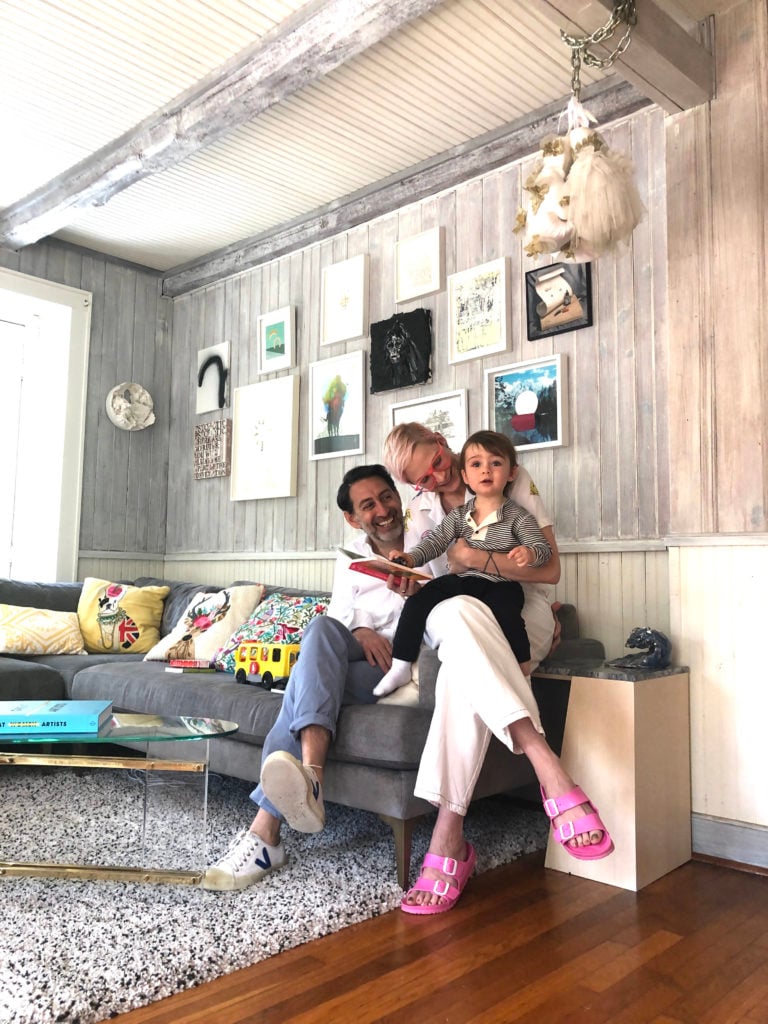
We asked art-world heavyweights to tell us about the artworks that are bringing them joy at home.

Artnet News

As we end yet another month spent largely at home, one thing that has become clear is that the things we surround ourselves with have become more important than ever. We checked in with a group of artists, curators, and dealers to ask about which works in their collections are keeping them inspired in these troubled times.
Here’s what they said.
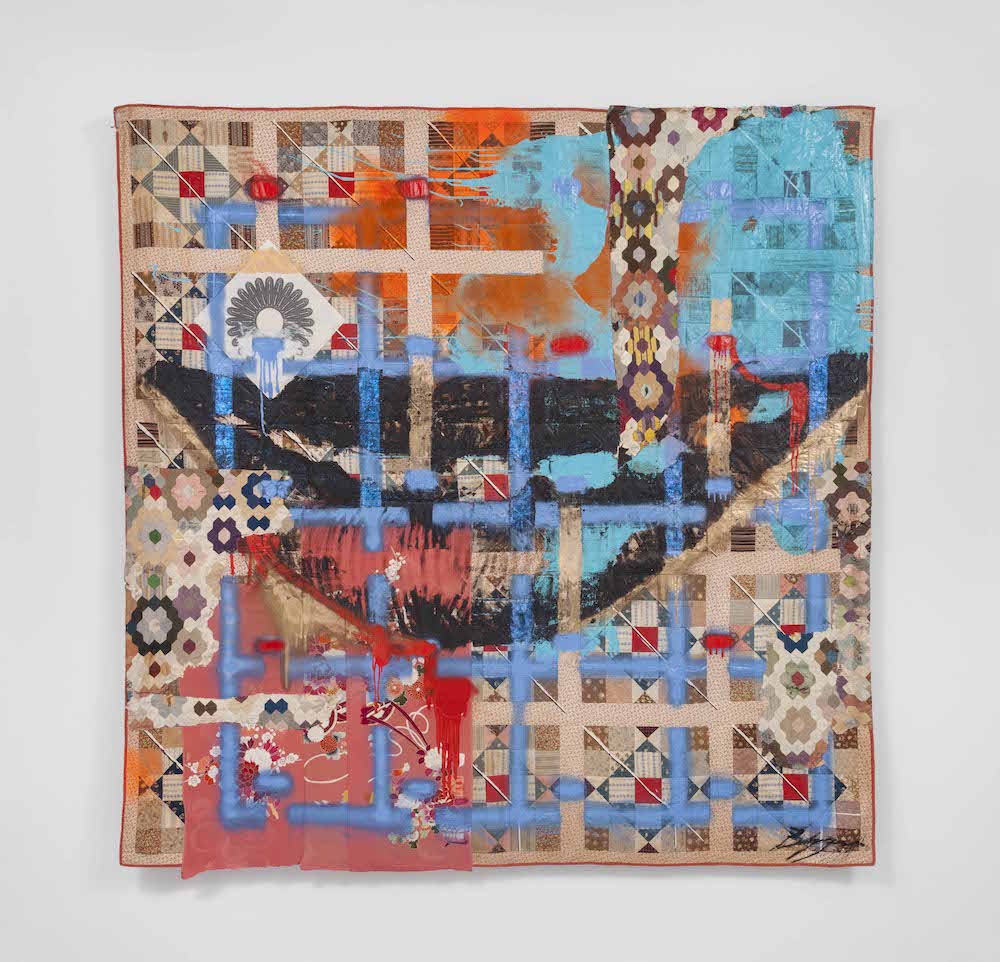
Sanford Biggers, Hat and Beard (2016). Image courtesy of Monique Meloche.
I set up my home office in Chicago at my kitchen table where I see both Rashid Johnson’s Black Love from my vantage point and Sanford Biggers’ Hat and Beard behind me in every zoom meeting. This is one of Johnson’s earliest black wax altarpieces and has hung in our kitchen sitting room since we acquired it in 2007. It has continued to gain new meaning through the years, but we’ve ruminated over the inexcusable mis-handling of the Ahmaud Arbery shooting during quarantine and this piece keeps striking a balance of calling out injustice with the brass funerary urn/makeshift altar while offering healing vibes with the music and shea butter offerings.
The smiling Cheshire grin in Biggers quilt painting Hat and Beard had proven to be a “friendly” backdrop for my frequent zoom meetings installed high above our back door. However, I find the more meditative details of the slave ship diagrams hidden in the lotus flower and the subtle, but rough application of the tar forming what I see more as a minstrel smile a constant reminder of the push and pull between beauty and political content throughout our collection.

Artist Katie Stout at home wearing Nicola L’s Forest (1970–78). Photo courtesy of Katie Stout.
Since quarantine, Nicola’s L’s Forest has become an emblem of cooperation and a reminder of our inherent connection to each other, despite our physical distance. I was reading The Overstory, and there’s a quote I like: “There are no individuals. There aren’t even separate species. Everything in the forest is the forest.”
Before quarantine, I perceived Forest as separate from me. After hours and hours and hours together, I began to understand her one-size-fits-all nature, so I stopped viewing Forest all together and finally tried her on. Probably wouldn’t have done that if it wasn’t for quarantine.

Courtesy of Markus Reymann.
One morning a few weeks ago, I found, when I reached for my phone after finishing my daily routine, the four drawings I am sharing with you from a WhatsApp conversation with Eduardo Navarro. A few years back, I had the great joy to go with Eduardo on two of TBA21–Academy’s programmed voyages to the Marquesas Islands and more recently to Aotearoa. Ever since, we regularly exchange thoughts about art, the ocean and what keeps us sane. Finding the drawings on my phone was naturally a huge joy and as soon it was possible, I printed and framed them. They have become valued companions accompanying me through these anxiety-inducing times.
But what I am really looking forward to is: we agreed that when we see each other again, the prints will be exchanged for Eduardo’s original drawings.
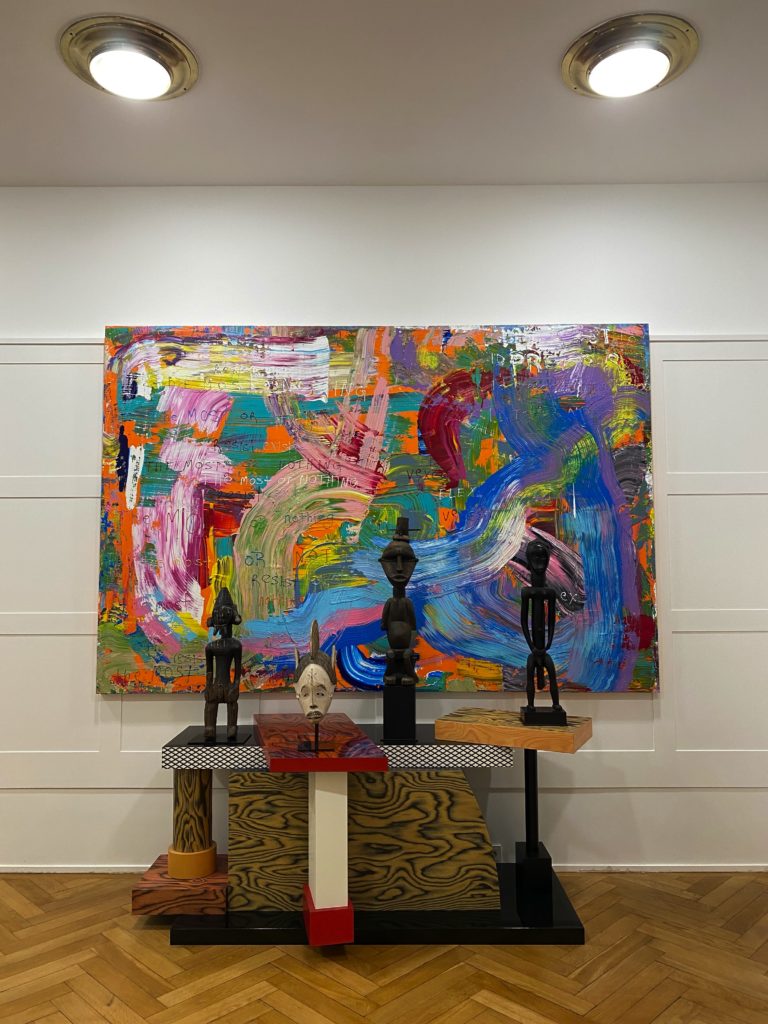
Richard Kennedy’s MX. BARTLEBY (2020); Jukun, Benue river area, Nigeria, male ancestor figure (Wurbo style), 19th century or earlier; Igbo, Nigeria, Agbogho Mmuo Mask, mid to late 19th century; Igbo (Ibeku, Oloro, Olokoro or Ngwa group), Umuahia area, Cross River, Nigeria, Figurative Male Ogbom Headdress, possibly late 19th – early 20th century; and Fang, Gabon, Reliquary Guardian Figure, Early 19th century. Courtesy Javier Peres.
I have one of Richard Kennedy’s new works in my house that he made during the lockdown that I’m obsessed with, called MX. BARTLEBY, which is such a wonderful compliment to an important group of classic African art mostly from present day Nigeria and one from Gabon. Richard’s work has a strong performative quality which for me goes very well with African art since most of these pieces were used in a variety of ritual contexts which to use would seem performative. Of course, the text in Richard’s painting is also poignant and gives me the perfect mantra for our times, THE MOST, RESIST OR NOTHING.
Nina was doing a residency in Brazil and I bought this right after she came back. It’s about optimism and also has cryptic messages about gender, race, and identity, in the best style that only Nina can do!
I love how graphic and strong this work is. It also reminds me of Nina’s own struggles and her persistence. Resiliency is one of the most important human qualities that I’ve cultivated throughout my life and this piece brings me a sense of resilience too.
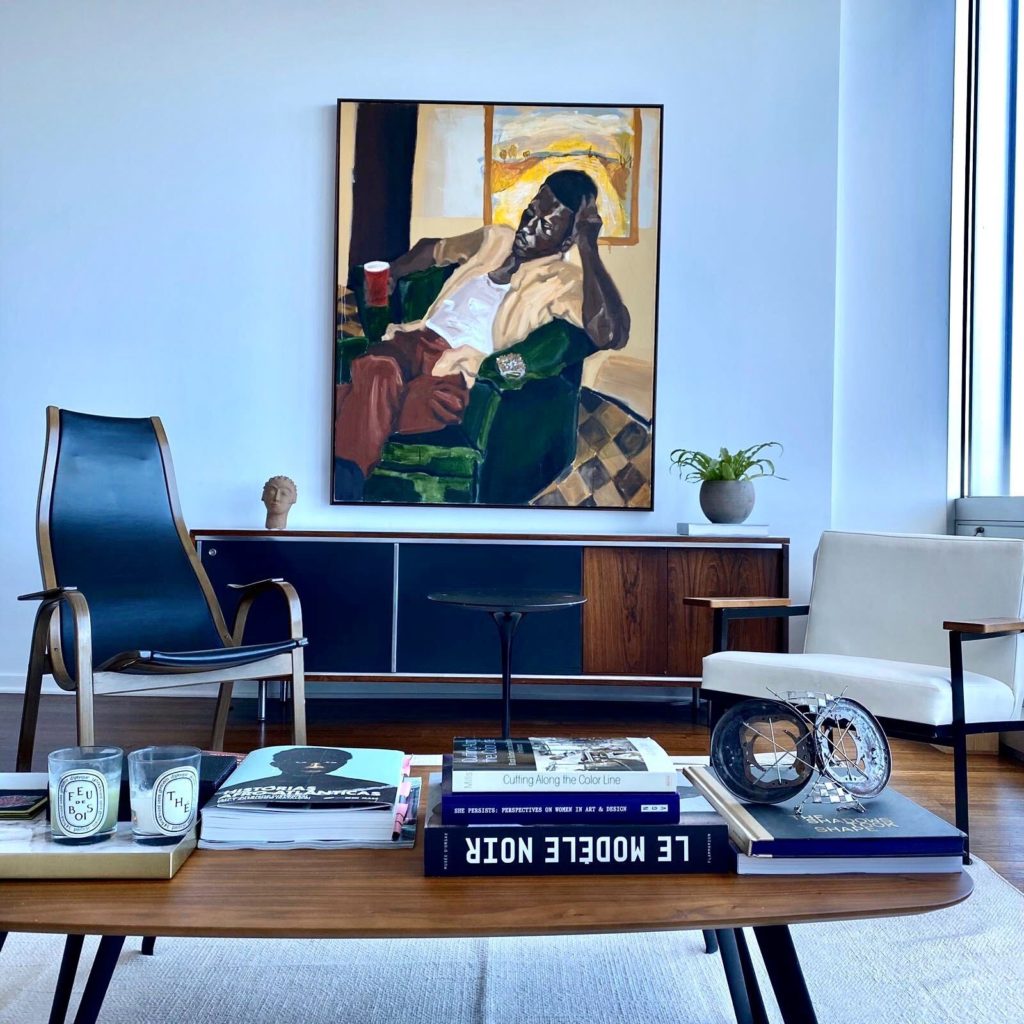
Jerrell Gibbs, Turner (2019), at art dealer Mariane Ibrahim’s home. Photo courtesy of Mariane Ibrahim.
Turner is the title of a painting by Jerrell Gibbs. This was the first piece my husband and I bought before any representation. It was love at first sight. The painting reminds me of The Thinker by Rodin. During these difficult times, it is important to reflect. I sit in front of this man seated on the green couch every morning, and contemplate. The longer I stare at the work, the more the work comes to life.
I enjoy the work of Yuji Ueda, a Japanese ceramic artist based in Shigaraki, an ancient pottery town about an hour away from Kyoto. Ueda creates pots in various sizes, which are rich in textures, adorned with layers of glazing and natural fissures. Every piece is truly unique and embraces the aesthetics of wabi-sabi. I like to put flowers in the pots or incense while meditating. It brings serenity to my life in quarantine.
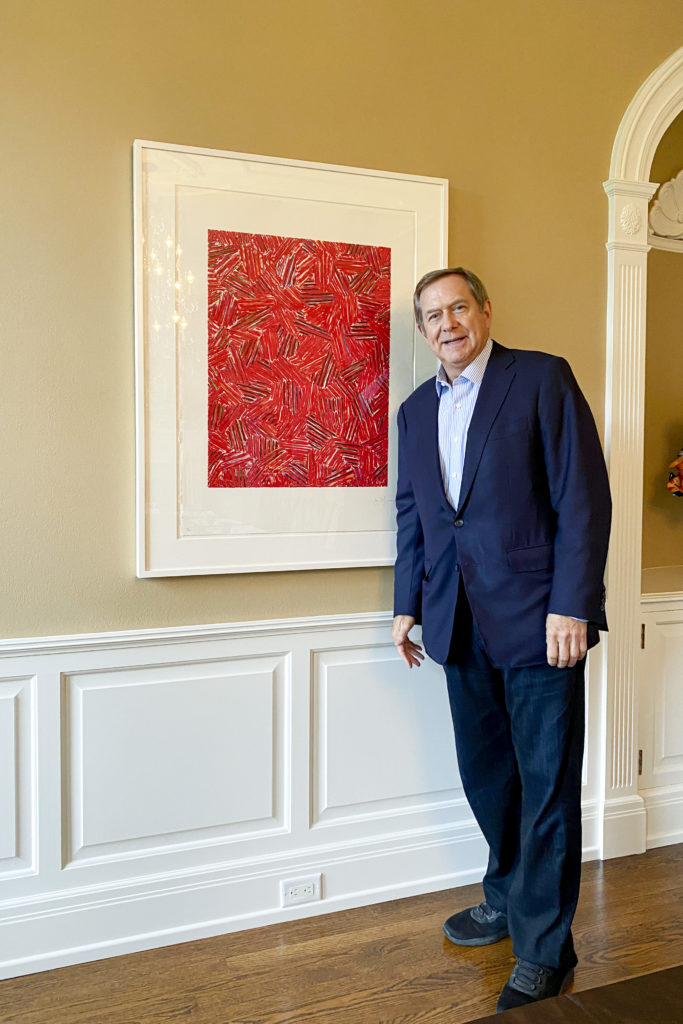
Jordan Schnitzer at home with his Jasper Johns lithograph
Cicada (1981). Photo courtesy of Jordan Schnitzer, publisher/printer Gemini G.E.L., Los Angeles.
Jasper Johns is one of the greatest artists of our time. Cicada, made in 1981, is a brilliant example of his cross-hatch series. A master colorist, the work takes my breath away. It draws me into another time and place. Thank you, Jasper!
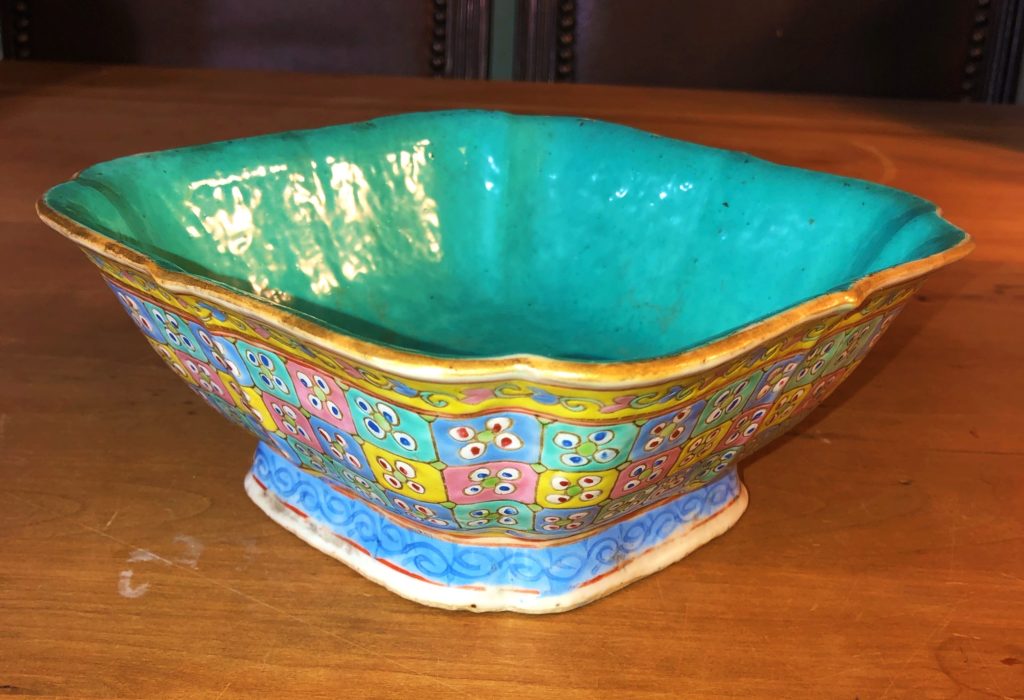
Qing dynasty porcelain bowl. Photo courtesy of Eugenie Tsai.
This porcelain bowl from the late Qing dynasty was part of my grandmother’s dowry when she wed in Shanghai at the turn of the 20th century. A few years ago, on a trip to Shanghai, my aunt gave it to me, along with a tea set that had belonged to my father. During the Cultural Revolution, the family home was ransacked and many possessions destroyed. My aunt didn’t reveal the hiding place of these fragile objects, but they survived, as did she. These emblems of survival and resilience resonate with me today.
This recent work on paper by London-based artist Caroline Walker hangs in the study of my London flat. I was instantly drawn to this contemplative portrait, which has a sense of calm focus. After discovering the inspiration and motivation behind Walker’s practice I was even more adamant to own this piece.
Walker is known for her depictions of female figures, who are usually at work and often seen alone, absorbed by their task at hand. Profiling women who work in the service industries, Walker considers how these roles are frequently overlooked, exploring the idea of invisibility, as in the artist’s own words, many of these jobs are typically ‘designed to be unseen’.
In these strange times we are living through, Walker’s work is particularly poignant, revealing and showcasing key workers that we rely on, but too often take for granted. Having this work close to me is a constant reminder of those people who are continuing to face their jobs with courage and determination, despite adversity.
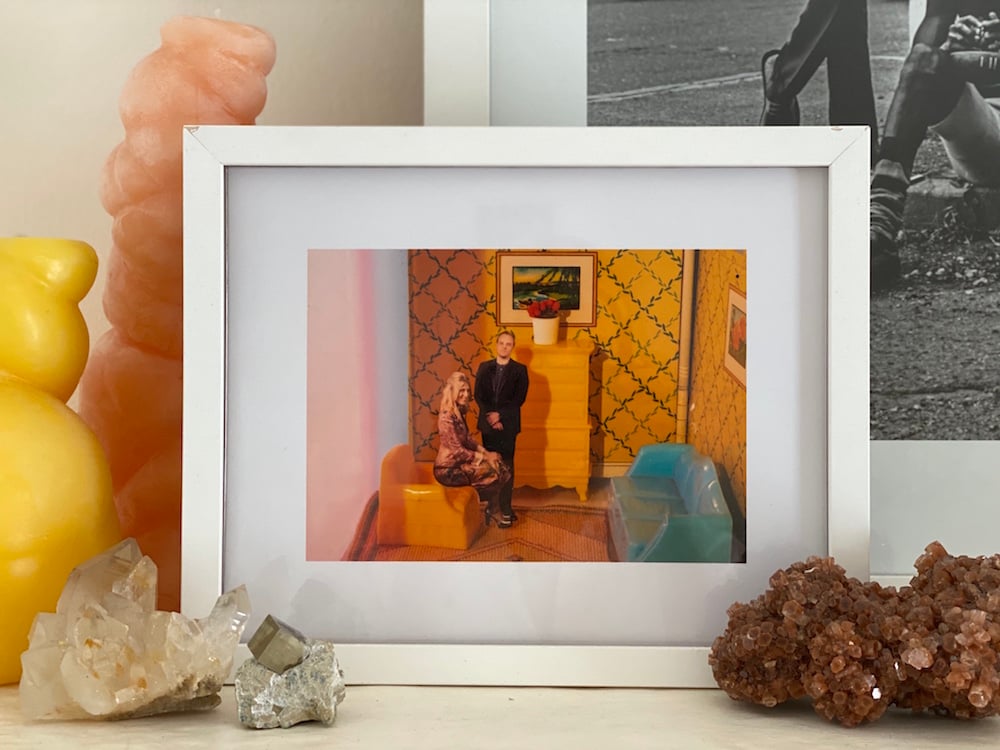
Laurie Simmons’s portrait of Casey Fremont and Brandon Crowe. Image courtesy Casey Fremont
Laurie Simmons photographed my husband and me at The Seagram Building during Art Production Fund’s 2018 gala. Our portrait was then collaged into one of her iconic dollhouse furniture environments, and this is the finished photo of the merged images. These portraits were sold at the gala as a fundraiser for APF. It makes me think not only of a wonderful night, back when we used to socialize without distance, but it reminds me of the incredible support and generosity that artists have shown Art Production Fund over the years. While being apart during this unprecedented time is unsettling for many reasons, I feel comforted by these memories and deep gratitude for our community of supporters.
Like everyone, I’ve been thinking a lot about my home and surroundings. I love the fantasy of this collaged image, the idea of being taken from one place and dropped in somewhere completely different. I can’t help but find it strangely prophetic of our current digital lives, set in virtual backgrounds.
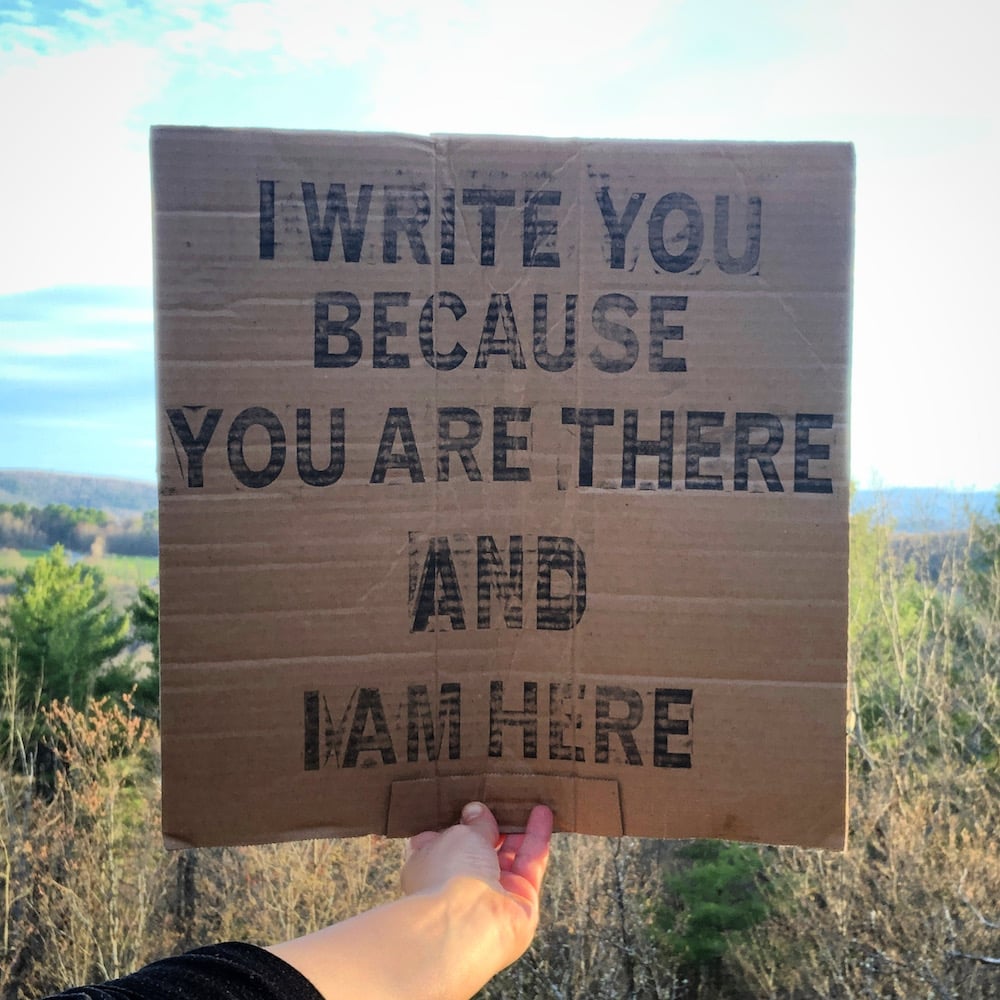
David Horvitz, I Write You Because You Are There and I Am Here (2020). Image via Margot Norton’s Instagram
David Horvitz has worked in mail art for many years as well as with net-based and viral art projects. After the pandemic hit, Horvitz started making works with this phrase, “I write you because you are there and I am here” and sending them to friends through the mail. There is a stamp on the work in ink, which identifies the text as being “sympathetically appropriated by Endre Tót.” Tót is a Fluxus artist known for his mail art projects with text-based declarations and conceptual prompts. As with Tót’s works, Horvitz’s projects gain momentum through word of mouth and physical movement or distribution. They demonstrate the significant ways that relationships, communication, and technology form an unconventional network of rituals that might challenge traditional systems and parameters. Horvitz’s often sly and always meaningful interventions draw attention to alternative ways of measuring, recording, and transmitting our distances. During this time of isolation, Horvitz’s project brings to mind the ways humans have connected with one another for centuries. Our current state of hyper-paced Zoom calls, emails, and images transmitted through screens can render the physical objects he sends—objects that often play with the size and material limitations imposed by the USPS—all the more gratifying and impactful.
My husband Eric stole my wedding dress and asked our dear friend and epic artist Zoë Buckman to make a special work as a surprise Christmas gift for me. We had been trying to have a baby for years and he asked Buckman to make three boxing gloves to symbolize the additional family member we hoped to have. A few days after I received this wonderful gift, I found out I was pregnant with Harry! So this piece really is full of love and is part of our everyday lives, hanging in the heart of our home.
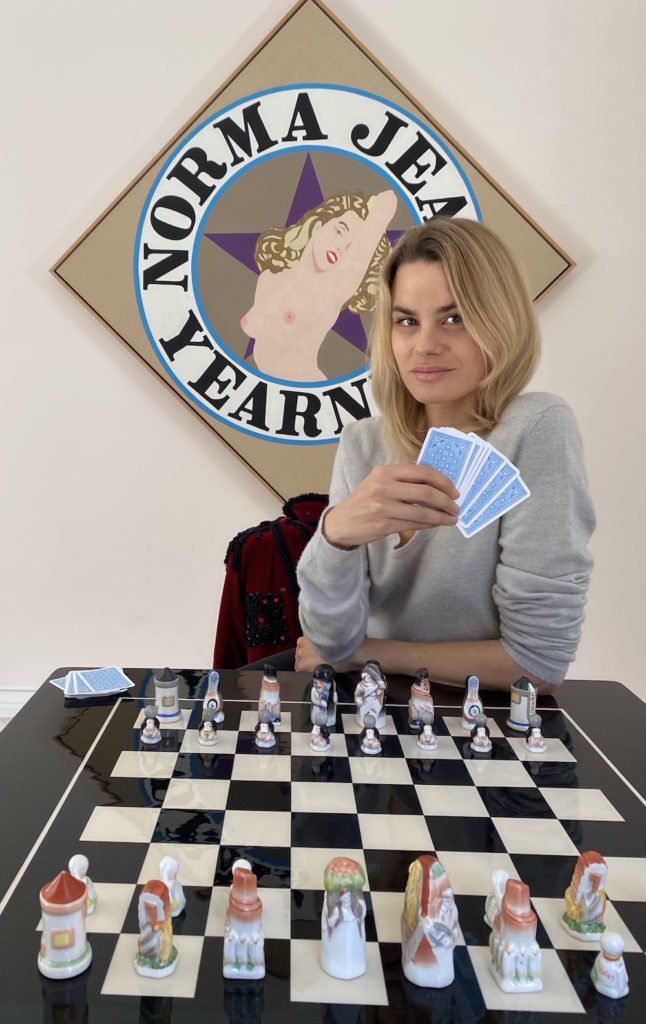
Isabelle Bscher with Robert Indiana’s Marilyn Marilyn II (1999). Image courtesy Isabelle Bscher
I always loved this painting, it reminds me of visiting Robert Indiana in Vinalhaven. It hangs in front of our game table where we spend hours playing risk, monopoly, or cards . Also I just saw Some Like it Hot again after years and it made me smile.
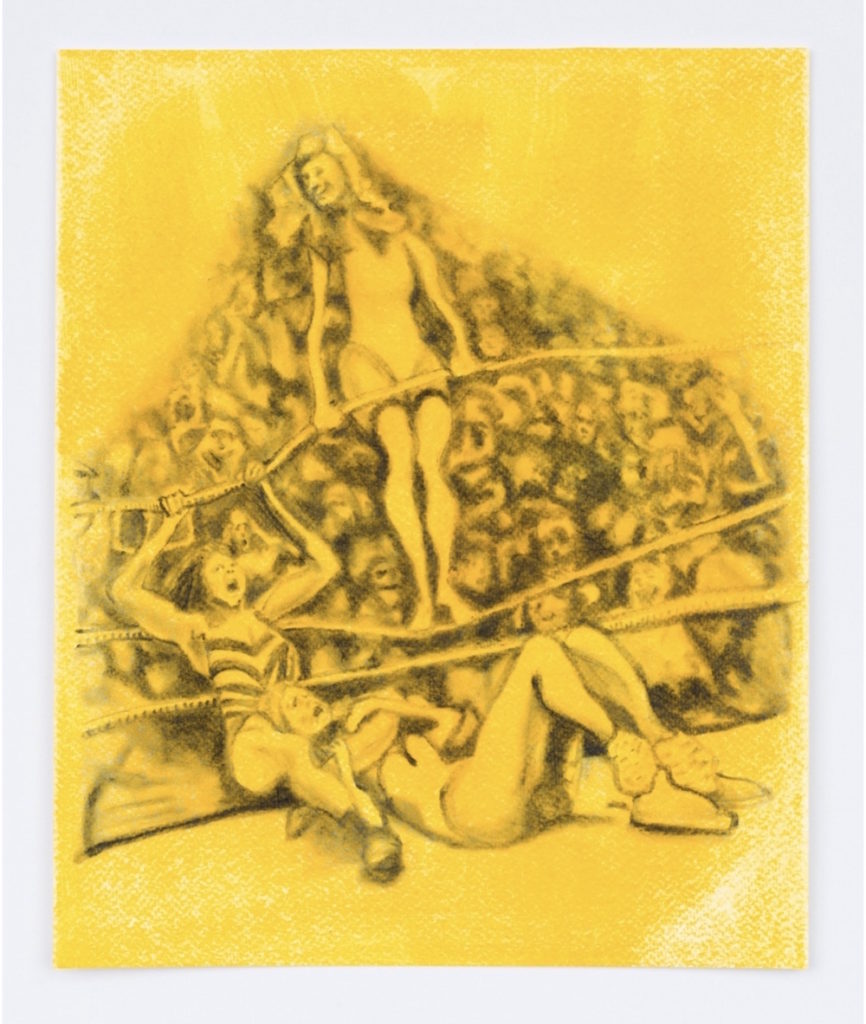
Rob Thom, Untitled (BLK + YLW Wrestling) (2018). Image courtesy Anna Zorina
This work by Rob Thom has been lifting my spirits these days. The piece shows a fight for control yet maintains a positive outlook. It’s a strange amount of people to be in a fight. The odd third person seems to have a benevolent force that could be the deciding factor of the struggle. Seems to make peace with the absurdity of the moment. Although there is a battle being waged we can have faith that positive forces are on our side.
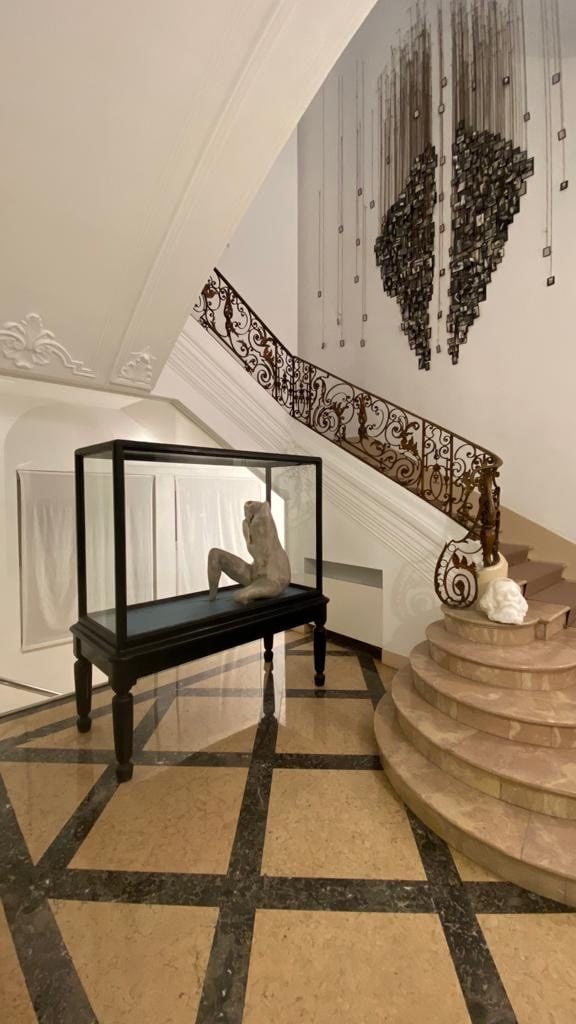
La femme sans tête by Berlinde De Bruyckere (2004) in situ at Patrizia Sandretto Re Rebaudengo’s residence in Turin. Photo courtesy Patrizia Sandretto Re Rebaudengo.
La femme sans tête by Berlinde De Bruyckere (2004) has been a particularly meaningful presence in my house during lockdown. It’s a female body cast in wax, headless and sealed in a museum vitrine. This figure conveys a sense of suffering, but also our need for protection. It represents the vulnerability that we are all experiencing in these times – how we feel fragile and broken in front of pain and death. But it also gives shape to a beauty that keeps on nurturing our love for life. The same conflicting emotions characterize the artist’s solo exhibition currently on view at Fondazione Sandretto Re Rebaudengo. The main installation at the core of the exhibition, Aletheia-On Vergeten, confronts us with an immense, devastating tragedy, and yet it is able to communicate a sense of inner peace, found in consolation and the hope of repair.

Abbas Akhavan, in mailhaye… , 2008. Courtesy of Sunny Rahbar and the Third Line, Dubai.

Billy Al Bengston, Tachometer Drive (1961), in Beth Rudin Dewoody’s Los Angeles bedroom. Courtesy of Beth Rudin Dewoody.
This work is one of Billy Al’s early paintings from his motorcycle series. It’s hanging on the wall to the left of my bed, so I look at it all the time. A ray of sunshine for the day, and a big star for the night. It def cheers me up and reminds me that nature and life go on, and how much we have to honor them and be grateful for all that we have.
This beautiful piece by Camila Sposati has been a great company at home during these strange times. Its evocative shape reminds me of an instrument for old rituals and it has an strong earthy feeling to me which is somehow calming. It makes me think of the planets, nature, traveling, plants, and cycles, and at the same time it has a robust presence as a body or an animal. A peaceful creature that functions as a guardian of the home or an amulet.
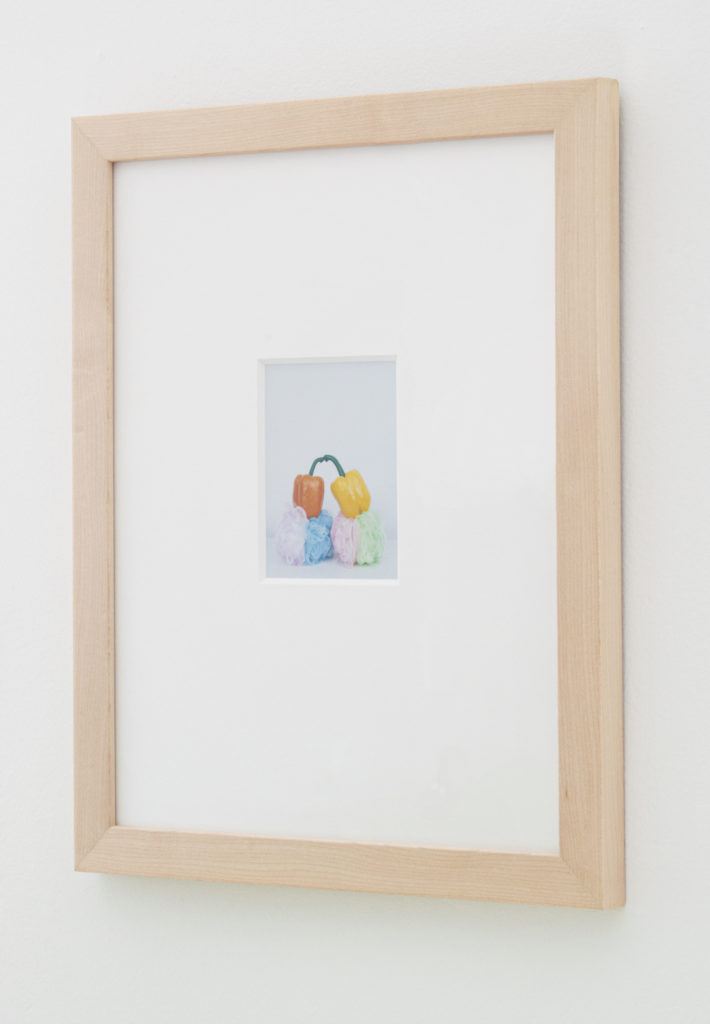
MarieVic, The Kiss, 2016. Photo by Sara Maria Salamone. Courtesy of Sara Maria Salamone and Mrs., New York.
This Polaroid by MarieVic was given to me and my husband by the artist as a wedding present. I love the playfulness of the readymade pictured and the humor in titling the work The Kiss, considering both the content of the image and the reason for the gift. This piece lives in our kitchen, where we appreciate it daily. It is especially dear to me, since MarieVic and I were in graduate school together at Parsons and have been longtime friends since.
I have an Alex Ebstein piece which is made of cut yoga mats that sits above my bed that I love. Now that I’ve been spending so much time at home I definitely look at it more and it reminds me of how important my health is. The pandemic has made me realize that jobs and money are replaceable but my health isn’t.
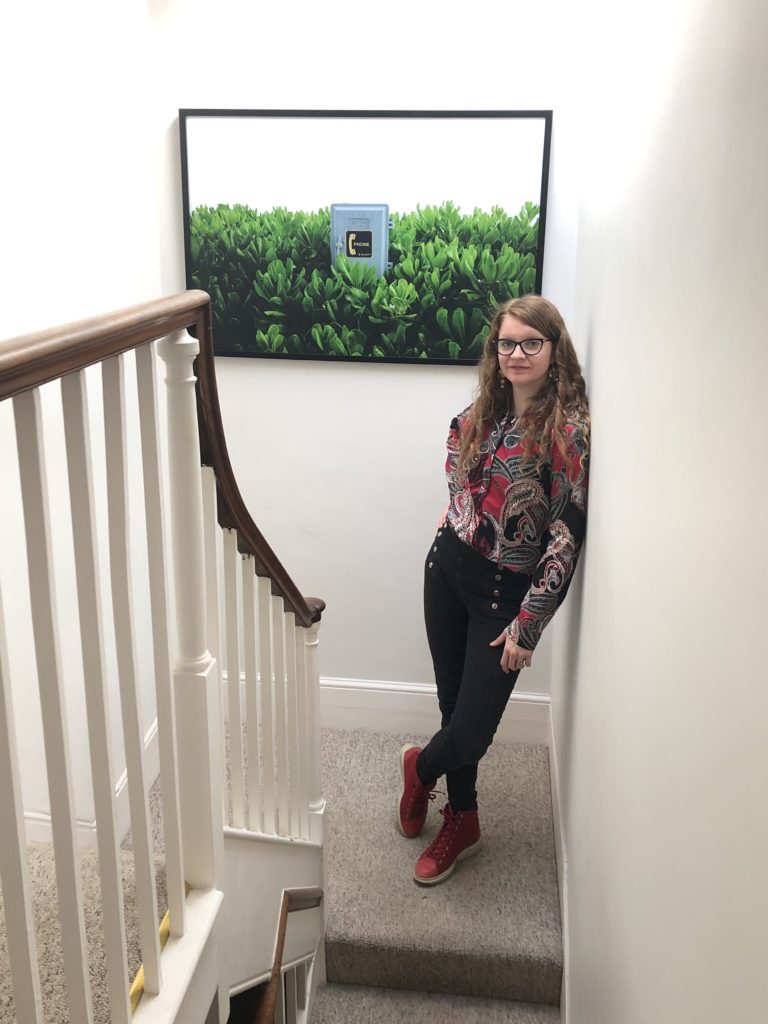
Susan Mumford with Answer | Ignore, a photograph by her husband, Chris E. King. Photo courtesy of Susan Mumford/Ivy Brown Gallery.
Spending every moment of every day at home in Lewes, East Sussex, England, with the exception of “essential” trips, has reinforced the importance of the immediate surrounds. The first week of lockdown saw the placement of a large colour photograph, Answer | Ignore (2014, Edn. 5) by my photographer husband Chris E. King.
Situated at the top of the stairwell in the early Georgian house, and opposite the bedroom and bathroom, the piece greets us throughout the day in trips up and down the house, bringing a spring to the step. The surreal scene of a phone box placed in a bed of brilliant green leaves takes on the seeming identity of a window that looks into another reality, all the while bringing a punch of colour to brighten the setting. Most recently, it’s garnered notable attention during video tours of the house (!).